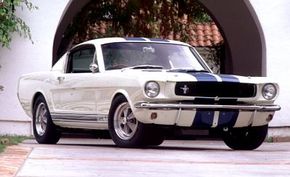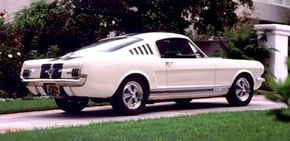Carroll Shelby, maker of the 1965-1966 Shelby GT-350, was a Texas chicken farmer who drove for Enzo Ferrari in the '50s and retired from racing for health reasons in 1960. He then became America's most charismatic maker of high-performance specialty cars. Between 1962 and 1970 he built or contributed to such blindingly fast machines as the awesome Cobra 289 and 427, as well as the Sunbeam Tiger and Ford's mid-engine GT40 and Mark IV competition cars. The last took Ford to the performance pinnacle with outright victories in the 24 Hours of Le Mans in 1966-69.
Shelby's most popular project from a sales standpoint was the GT-350, a super-tuned version of the Ford Mustang. It was born of Dearborn's desire to give its new 1965 "ponycar" a solid performance image, and it did precisely that by reigning as national Sports Car Club of America B-production champion for three years in a row (1965-67).
Advertisement
The GT-350 began as a white Mustang 2+2 fastback delivered to Shelby-American's small Venice, California, shop with Ford's "Hi-Performance" 289 V-8 and four-speed manual gearbox options. Shelby applied a "High-Riser" manifold, big four-barrel carb, hot cam, and free-flow exhaust headers, plus trailing arms to locate a rear axle borrowed from Ford's big Galaxie to replace the stock, light-duty Falcon assembly. This brought bigger drum brakes in the rear that Shelby fitted with metallic linings, while Kelsey-Hayes disc brakes were used in front.
Also installed were Koni adjustable shocks, quick-ratio steering box, front anti-sway bar, a stout steel-tube underhood brace, and 15-inch cast-aluminum wheels with high-performance Goodyear tires. Finally, the front suspension's forward mounts were relocated for optimum geometry. The result of all this was near-neutral handling instead of the standard Mustang's strong understeer -- plus ferocious performance with 306 rated horsepower, versus the factory's 271.
Outside, the Mustang's prancing pony was relocated on the grille, the stock steel hood was replaced by a fiberglass replica with functional scoop, and broad blue racing stripes were applied to rocker panels and atop hood, roof, and trunklid. Inside were racing seatbelts, wood-rim steering wheel, full instrumentation -- and no back seat, in order to qualify the GT-350 as a "sports car" under SCCA rules.
But this was just for the street. For the track, Shelby devised a "GT-350R" with special high-power heads, super-duty suspension, racing tires, aluminum transmission case, stripped interior, and a bumperless fiberglass nose with rudimentary air dam and large central air slot. All this reduced curb weight by some 300 pounds. Per his philosophy, Carroll made most of the special racing parts available over-the-counter at selected Ford dealers.
Go to the next page for more details on the 1965-1966 Shelby GT-350.
For more information on cars, see:
- Classic Cars
- Muscle Cars
- Sports Cars
- Consumer Guide New Car Search
- Consumer Guide Used Car Search
Advertisement

